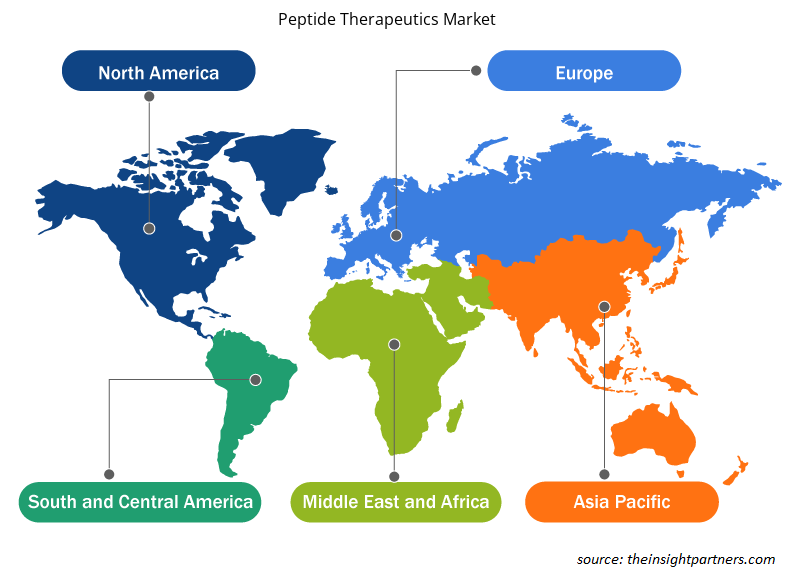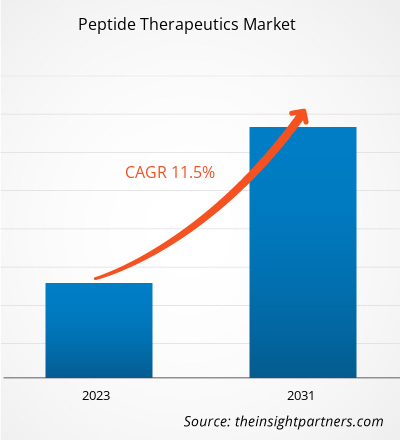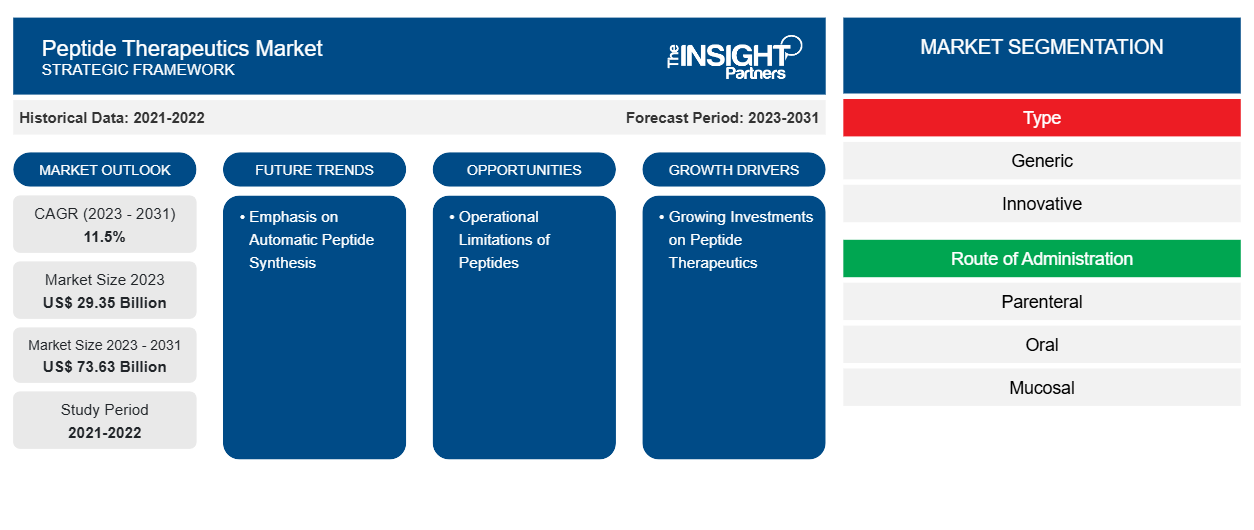Le marché des thérapies peptidiques devrait atteindre 73,63 milliards USD d'ici 2031, contre 29,35 milliards USD en 2023. Le marché devrait enregistrer un TCAC de 11,5 % en 2023-2031. La popularité croissante de la réduction du rythme de fabrication des médicaments peptidiques et l'adoption de nouvelles technologies devraient rester les principales tendances du marché des thérapies peptidiques.
Analyse du marché des thérapies peptidiques
Alors que le fardeau mondial des maladies chroniques augmente, la demande d'approches thérapeutiques ciblées et efficaces augmente. Avec leur précision et leur spécificité, les thérapies peptidiques s'avèrent être une solution convaincante qui répond aux besoins thérapeutiques de diverses maladies chroniques. Des pipelines de recherche robustes promettent un avenir plein de thérapies peptidiques innovantes et révolutionnaires. L'évolution vers la médecine personnalisée est cohérente avec les propriétés uniques des thérapies peptidiques. Comme les peptides se révèlent prometteurs dans le traitement des maladies rares, les sociétés pharmaceutiques se concentrent sur le développement de solutions thérapeutiques pour des populations de patients de niche. Les innovations dans les méthodes de synthèse conduisent à des peptides plus complexes et spécialisés, élargissant l'arsenal thérapeutique disponible pour les professionnels de la santé. En outre, les efforts combinés dans les initiatives de recherche entre les scientifiques et les acteurs du marché stimulent l'innovation sur le marché des thérapies peptidiques. De plus, les partenariats et les alliances créent des synergies qui font progresser le développement de thérapies de pointe à base de peptides. Cependant, les réglementations strictes et les coûts élevés de développement des médicaments devraient freiner la croissance du marché.
Aperçu du marché des thérapies peptidiques
Le marché des peptides thérapeutiques émerge comme un secteur dynamique et prometteur au sein de l'industrie pharmaceutique, offrant une approche unique pour traiter diverses maladies et conditions médicales. Les peptides thérapeutiques composés de courtes séquences d'acides aminés ont attiré une attention considérable en raison de leur spécificité, de leur efficacité et de leurs applications potentielles dans divers domaines thérapeutiques. Ce marché émergent se situe à l'intersection de l'innovation et de la science médicale et est sur le point de remodeler le paysage des soins de santé. Le marché comprend divers peptides, des analogues naturels aux analogues synthétiques, conçus pour améliorer les résultats thérapeutiques. Ces peptides sont des agents polyvalents ciblant des récepteurs, des enzymes ou des mécanismes cellulaires spécifiques, ce qui en fait un outil précieux en médecine de précision.
Personnalisez ce rapport en fonction de vos besoins
Vous bénéficierez d'une personnalisation gratuite de n'importe quel rapport, y compris de certaines parties de ce rapport, d'une analyse au niveau des pays, d'un pack de données Excel, ainsi que de superbes offres et réductions pour les start-ups et les universités.
- Obtenez les principales tendances clés du marché de ce rapport.Cet échantillon GRATUIT comprendra une analyse de données, allant des tendances du marché aux estimations et prévisions.
Moteurs et opportunités du marché des thérapies peptidiques
La prévalence croissante des troubles métaboliques et des maladies infectieuses favorise le marché
Selon un article de la National Library of Medicine, les maladies infectieuses restent l'une des principales causes de maladie et de mortalité dans le monde, causant plus de 52 millions de décès par an dans le monde. Selon l'IDF publiée en décembre 2021, environ 14 millions d'adultes au Mexique souffrent de diabète. Les peptides tels que l'amide (GLP-1) sont efficaces dans le traitement du diabète. En février 2022, le gouvernement provincial de la Nouvelle-Écosse a signalé que les Néo-Écossais se sont inscrits à des programmes d'assurance-médicaments qui commenceraient à passer à une version biosimilaire de certains médicaments biologiques, dont certaines insulines et certains médicaments, pour le traitement de la maladie de Crohn et des rhumatismes. L'augmentation des cas de certains troubles métaboliques, tels que le dysfonctionnement des organes, les troubles génétiques et le dysfonctionnement mitochondrial, est l'un des facteurs qui stimulent la croissance du marché. Le stockage progressif des glucocérébrosides dans les macrophages, principalement dans les os, la moelle osseuse, la rate et le foie, est l'indication de la maladie de Gaucher (GD), qui est un trouble de stockage lysosomal autosomique récessif. Selon le Journal of Pediatric Haematology/Oncology (JPHO), en juillet 2022, la prévalence des cas de GD pour 100 000 naissances vivantes dans le monde était de 1,5. Par conséquent, la forte prévalence des maladies infectieuses et métaboliques stimule la demande de thérapies peptidiques pour traiter ces maladies, stimulant ainsi la croissance du marché.IDF published in December 2021, an estimated 14 million adults in Mexico have diabetes. Peptides such as amide (GLP-1) are effective in treating diabetes. In February 2022, the Nova Scotia provincial government reported that Nova Scotians have registered in pharmacare programs that would begin switching to a biosimilar version of certain biologic medicines, including some insulins and medications, for the treatment of Crohn's disease and rheumatism. The increasing cases of some metabolic disorders, such as organ dysfunction, genetic disorders, and mitochondrial dysfunction, are one of the factors that drive the market growth. The progressive storage of glucocerebrosides in macrophages, primarily in the bone, bone marrow, spleen, and liver are the indications of Gaucher disease (GD) which is an autosomal recessive lysosomal storage disorder. As per the Journal of Pediatric Haematology/Oncology (JPHO), in July 2022, the prevalence of GD cases per 100,000 live births worldwide was 1.5. Therefore, the high prevalence of infectious and metabolic diseases drives the demand for peptide therapeutics for treating these diseases, thereby boosting market growth.
Un pipeline et des applications solides de médicaments peptidiques – une opportunité pour la croissance du marché des thérapies peptidiques
Les indications les plus courantes des peptides sont l'oncologie, l'endocrinologie et les maladies métaboliques. Parmi les autres domaines cibles des peptides qui ont retenu l'attention figurent la gastroentérologie , les maladies cardiovasculaires, la dermatologie, les maladies osseuses et les dysfonctionnements sexuels. En raison de leur forte immunogénicité, les vaccins peptidiques ont également un grand potentiel pour devenir une alternative aux vaccins classiques car ils sont entièrement synthétiques et ne provoquent pas d'effets secondaires indésirables. Pour surmonter leurs limites, diverses modifications des peptides ont été introduites. En outre, les études en cours liées à l'application des peptides devraient avoir un impact positif sur le pipeline, offrant ainsi des opportunités lucratives de croissance du marché. Voici quelques pipelines de médicaments peptidiques :immunogenicity, peptide vaccines also have great potential to become an alternative to classical vaccines as they are completely synthetic and do not cause undesirable side effects. To overcome their limitations, various modifications of peptides have been introduced. Furthermore, the ongoing studies related to the application of peptides are expected to positively impact the pipeline, thereby providing lucrative opportunities for market growth. Some peptide drug pipelines are as follows:
Entreprise | Peptide | Espace thérapeutique | Stade de développement |
3B Pharmaceuticals (Allemagne) | FAP-2286 | Oncologie-Tumeurs exprimant la FAP | Essais cliniques de phase I |
3B 401 | Tumeurs neuroendocrines | Essais précliniques | |
Allysta Pharmaceuticals (États-Unis) | ALY688 | Ophtalmologie – Maladie des yeux secs | Essais cliniques de phase II |
ALY688SR | Maladies du foie et obésité | Essais cliniques de phase I |
Source : Issar Pharma, Willing Wellness
Analyse de segmentation du rapport sur le marché des thérapies peptidiques
Les segments clés qui ont contribué à la dérivation de l’analyse du marché des thérapies peptidiques sont les composants, les applications et l’utilisateur final.
- En fonction du type, le marché des thérapies peptidiques est divisé en génériques et en innovants. Le segment innovant détenait la plus grande part du marché en 2023, tandis que le segment générique devrait enregistrer le TCAC le plus élevé au cours de la période de prévision.CAGR during the forecast period.
- En fonction de la voie d'administration, le marché est segmenté en parentéral, oral, muqueux, pulmonaire, autres. Le segment parentéral détenait la plus grande part du marché en 2023, et le segment oral devrait enregistrer le TCAC le plus élevé au cours de la période 2023-2031.CAGR during 2023–2031.
- Sur la base de la technologie de synthèse, le marché des thérapies peptidiques est divisé en synthèse peptidique en phase solide (SPPS), synthèse peptidique en phase liquide (LPPS) et technologie hybride. Le segment de la synthèse peptidique en phase solide détenait la plus grande part du marché en 2023. Cependant, le segment de la technologie hybride devrait enregistrer le TCAC le plus élevé au cours de la période de prévision.CAGR during the forecast period.
- En termes d'application, le marché est segmenté en cancer, troubles cardiovasculaires, troubles métaboliques, troubles respiratoires , douleur et dermatologie. Le segment du cancer détenait la plus grande part du marché en 2023. Cependant, le segment des troubles métaboliques devrait enregistrer le TCAC le plus élevé au cours de la période 2023-2031.CAGR during 2023–2031.
Analyse des parts de marché des thérapies peptidiques par géographie
La portée géographique du rapport sur le marché des thérapies peptidiques est principalement divisée en cinq régions : Amérique du Nord, Asie-Pacifique, Europe, Moyen-Orient et Afrique, et Amérique du Sud/Amérique du Sud et centrale.
L'Amérique du Nord domine le marché des thérapies peptidiques. La croissance du marché en Amérique du Nord est attribuée aux institutions universitaires renommées, aux laboratoires de pointe et aux collaborations entre la science et l'industrie qui contribuent à un écosystème de R&D dynamique qui favorise la découverte et le développement de nouveaux peptides à potentiel thérapeutique. En Amérique du Nord, le secteur de la biotechnologie joue un rôle important dans le développement de thérapies peptidiques. La présence de sociétés de biotechnologie de premier plan et un environnement réglementaire favorable favorisent la traduction des résultats de la recherche en traitements à base de peptides cliniquement viables, positionnant l'Amérique du Nord comme un leader dans le domaine mondial des thérapies peptidiques. La prévalence des maladies chroniques en Amérique du Nord souligne le besoin de solutions thérapeutiques avancées. Grâce à leurs mécanismes d'action ciblés, les thérapies peptidiques s'avèrent être des candidats prometteurs pour le traitement de maladies telles que le diabète, les maladies cardiovasculaires (MCV) et divers types de cancer. L'Asie-Pacifique devrait connaître le TCAC le plus élevé dans les années à venir.
Aperçu régional du marché des thérapies peptidiques
Les tendances régionales et les facteurs influençant le marché des thérapies peptidiques tout au long de la période de prévision ont été expliqués en détail par les analystes d’Insight Partners. Cette section traite également des segments et de la géographie du marché des thérapies peptidiques en Amérique du Nord, en Europe, en Asie-Pacifique, au Moyen-Orient et en Afrique, ainsi qu’en Amérique du Sud et en Amérique centrale.

- Obtenez les données régionales spécifiques au marché des thérapies peptidiques
Portée du rapport sur le marché des thérapies peptidiques
| Attribut de rapport | Détails |
|---|---|
| Taille du marché en 2023 | 29,35 milliards de dollars américains |
| Taille du marché d'ici 2031 | 73,63 milliards de dollars américains |
| Taux de croissance annuel composé mondial (2023-2031) | 11,5% |
| Données historiques | 2021-2022 |
| Période de prévision | 2023-2031 |
| Segments couverts | Par type
|
| Régions et pays couverts | Amérique du Nord
|
| Leaders du marché et profils d'entreprises clés |
|
Densité des acteurs du marché : comprendre son impact sur la dynamique des entreprises
Le marché des thérapies peptidiques connaît une croissance rapide, tirée par la demande croissante des utilisateurs finaux en raison de facteurs tels que l'évolution des préférences des consommateurs, les avancées technologiques et une plus grande sensibilisation aux avantages du produit. À mesure que la demande augmente, les entreprises élargissent leurs offres, innovent pour répondre aux besoins des consommateurs et capitalisent sur les tendances émergentes, ce qui alimente davantage la croissance du marché.
La densité des acteurs du marché fait référence à la répartition des entreprises ou des sociétés opérant sur un marché ou un secteur particulier. Elle indique le nombre de concurrents (acteurs du marché) présents sur un marché donné par rapport à sa taille ou à sa valeur marchande totale.
Les principales entreprises opérant sur le marché des thérapies peptidiques sont :
- Eli Lilly et compagnie,
- Amgen Inc.,
- Teva Pharmaceutical Industries Ltd.,
- Lonza,
- Sanofi,
- Société Bristol-Myers Squibb,
Avis de non-responsabilité : les sociétés répertoriées ci-dessus ne sont pas classées dans un ordre particulier.

- Obtenez un aperçu des principaux acteurs du marché des thérapies peptidiques
Actualités et développements récents du marché des thérapies peptidiques
Le marché des thérapies peptidiques est évalué en collectant des données qualitatives et quantitatives après des recherches primaires et secondaires, qui comprennent d'importantes publications d'entreprise, des données d'association et des bases de données. Voici une liste des évolutions du marché des thérapies peptidiques :
- Novo Nordisk a annoncé que la Food and Drug Administration (FDA) des États-Unis a approuvé une indication supplémentaire pour Wegovy afin de réduire le risque d'événements cardiovasculaires majeurs tels que décès, crise cardiaque ou accident vasculaire cérébral chez les adultes atteints d'une maladie cardiaque connue et souffrant d'obésité ou de surpoids, ainsi que d'un régime hypocalorique et d'une activité physique accrue. (Novo Nordisk A/S, communiqué de presse, 2024)
- Ono Pharmaceutical Co., Ltd. a annoncé avoir conclu un accord de collaboration en matière de découverte de médicaments avec PeptiDream Inc., pour découvrir et développer de nouveaux médicaments à base de peptides macrocycliques contraints contre de multiples cibles. Selon les termes de l'accord, PeptiDream identifiera et optimisera les candidats médicaments à base de peptides macrocycliques contraints pour de multiples cibles d'intérêt sélectionnées par Ono, en utilisant la technologie exclusive Peptide Discovery Platform System (PDPS) de PeptiDream. (Source : ONO PHARMACEUTICAL CO., LTD., News, 2023)
- Biosynth, fournisseur de matériaux essentiels pour l'industrie des sciences de la vie, a annoncé l'acquisition de Pepceuticals, un producteur britannique de peptides synthétiques doté d'installations GMP de plusieurs kilos et de capacités de remplissage et de finition conçues pour accompagner les clients depuis les essais cliniques jusqu'à l'approvisionnement commercial. L'acquisition permet de soutenir toutes les phases du cycle de vie du produit, de la découverte à la commercialisation. (Source : Biosynth, News, 2023)
- IRBM, une organisation innovante de recherche sous contrat, a annoncé la signature d'un nouvel accord avec Merck & Co. Inc., pour poursuivre leur collaboration dans le domaine des thérapies peptidiques. Cette collaboration permet de combiner l'expertise scientifique de premier ordre de l'IRBM en matière de conception et de synthèse de peptides avec les capacités exceptionnelles de développement de médicaments de Merck & Co. Inc., en mettant l'accent sur la fourniture de thérapies innovantes aux patients qui en ont besoin. (Source : IRBM SpA ; Communiqué de presse ; 2023)
- Des chercheurs de l'Université d'Hokkaido ont mis au point une nouvelle méthode pour concevoir et développer des antibiotiques peptidiques en grande quantité, ce qui s'avérera essentiel pour contrôler la résistance aux antibiotiques. (Université d'Hokkaido, communiqué de presse, 2023)
Rapport sur le marché des thérapies peptidiques et livrables
Le rapport « Taille et prévisions du marché des thérapies peptidiques (2021-2031) » fournit une analyse détaillée du marché couvrant les domaines ci-dessous :
- Taille du marché et prévisions aux niveaux mondial, régional et national pour tous les segments de marché clés couverts par le périmètre
- Dynamique du marché, comme les facteurs moteurs, les contraintes et les opportunités clés
- Principales tendances futures
- Analyse détaillée des cinq forces de PEST/Porter et SWOT
- Analyse du marché mondial et régional couvrant les principales tendances du marché, les principaux acteurs, les réglementations et les développements récents du marché
- Analyse du paysage industriel et de la concurrence couvrant la concentration du marché, l'analyse de la carte thermique, les principaux acteurs et les développements récents
- Profils d'entreprise détaillés
- Analyse historique (2 ans), année de base, prévision (7 ans) avec TCAC
- Analyse PEST et SWOT
- Taille du marché Valeur / Volume - Mondial, Régional, Pays
- Industrie et paysage concurrentiel
- Ensemble de données Excel
Rapports récents
Témoignages
Raison d'acheter
- Prise de décision éclairée
- Compréhension de la dynamique du marché
- Analyse concurrentielle
- Connaissances clients
- Prévisions de marché
- Atténuation des risques
- Planification stratégique
- Justification des investissements
- Identification des marchés émergents
- Amélioration des stratégies marketing
- Amélioration de l'efficacité opérationnelle
- Alignement sur les tendances réglementaires





















 Obtenez un échantillon gratuit pour - Marché des thérapies peptidiques
Obtenez un échantillon gratuit pour - Marché des thérapies peptidiques